Sustainability in IT Education
VerifiedAdded on 2020/04/21
|10
|3558
|51
AI Summary
This assignment analyzes three articles focusing on incorporating sustainability into information technology (IT) education within higher education institutions (HEIs). The analysis examines methods used by IT institutions to promote sustainability, the impact of educational programs on student mindsets, and the effectiveness of tools like ECT files in assessing curriculum sustainability. It highlights the importance of integrating sustainability across various aspects of HEI operations and curricula.
Contribute Materials
Your contribution can guide someone’s learning journey. Share your
documents today.
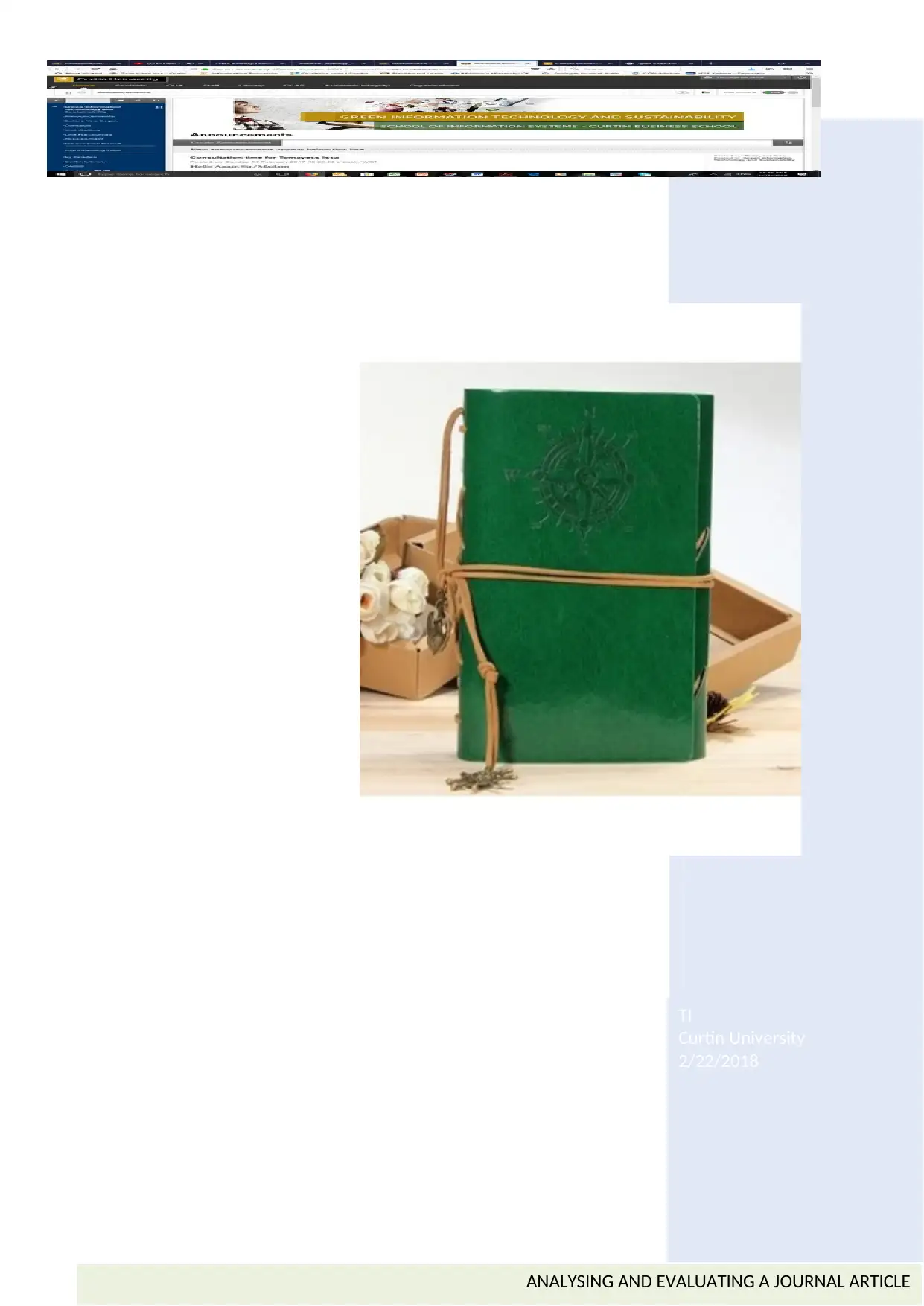
TI
Curtin University
2/22/2018
ANALYSING AND EVALUATING A JOURNAL ARTICLE
Curtin University
2/22/2018
ANALYSING AND EVALUATING A JOURNAL ARTICLE
Secure Best Marks with AI Grader
Need help grading? Try our AI Grader for instant feedback on your assignments.
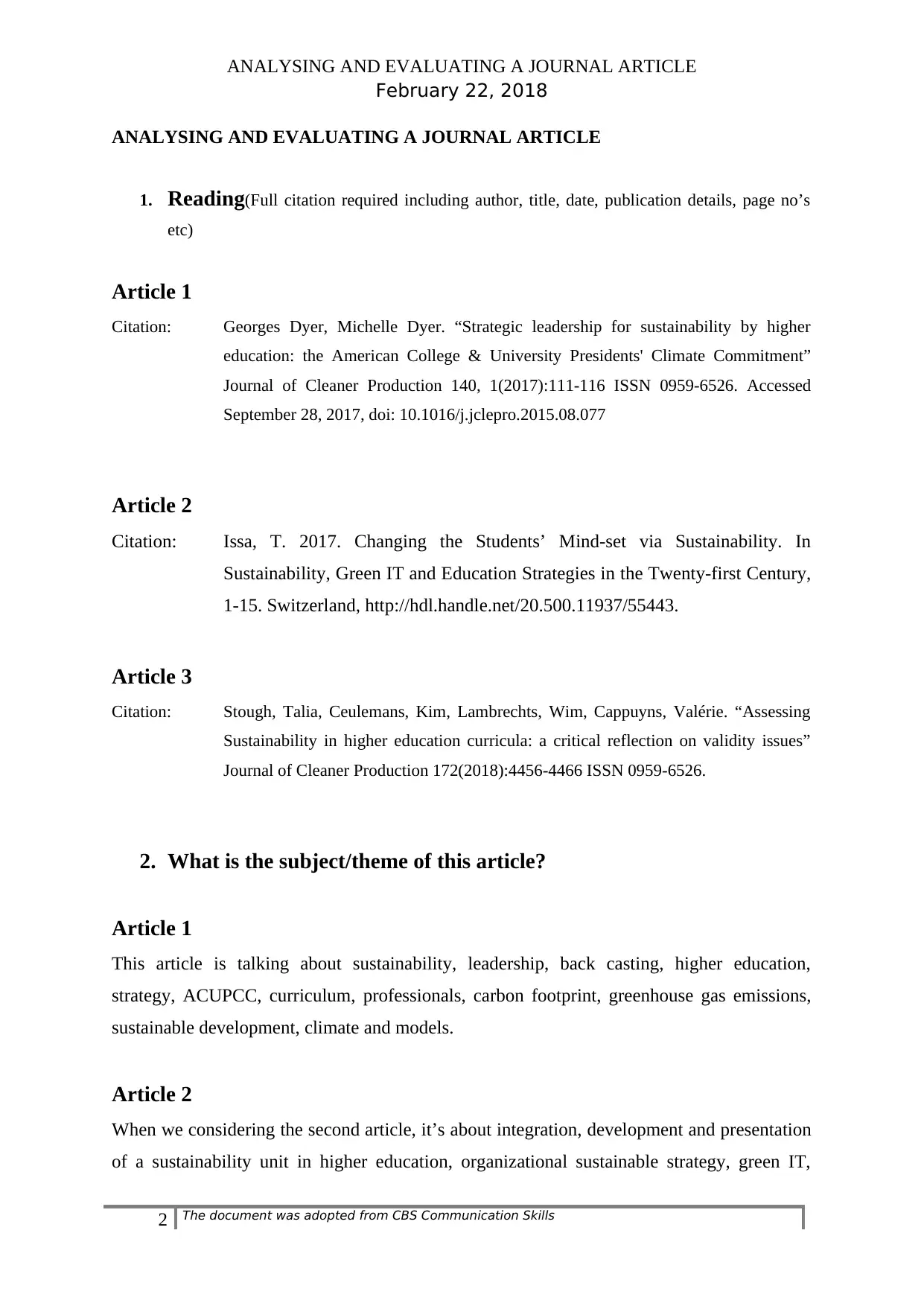
ANALYSING AND EVALUATING A JOURNAL ARTICLE
February 22, 2018
ANALYSING AND EVALUATING A JOURNAL ARTICLE
1. Reading(Full citation required including author, title, date, publication details, page no’s
etc)
Article 1
Citation: Georges Dyer, Michelle Dyer. “Strategic leadership for sustainability by higher
education: the American College & University Presidents' Climate Commitment”
Journal of Cleaner Production 140, 1(2017):111-116 ISSN 0959-6526. Accessed
September 28, 2017, doi: 10.1016/j.jclepro.2015.08.077
Article 2
Citation: Issa, T. 2017. Changing the Students’ Mind-set via Sustainability. In
Sustainability, Green IT and Education Strategies in the Twenty-first Century,
1-15. Switzerland, http://hdl.handle.net/20.500.11937/55443.
Article 3
Citation: Stough, Talia, Ceulemans, Kim, Lambrechts, Wim, Cappuyns, Valérie. “Assessing
Sustainability in higher education curricula: a critical reflection on validity issues”
Journal of Cleaner Production 172(2018):4456-4466 ISSN 0959-6526.
2. What is the subject/theme of this article?
Article 1
This article is talking about sustainability, leadership, back casting, higher education,
strategy, ACUPCC, curriculum, professionals, carbon footprint, greenhouse gas emissions,
sustainable development, climate and models.
Article 2
When we considering the second article, it’s about integration, development and presentation
of a sustainability unit in higher education, organizational sustainable strategy, green IT,
2 The document was adopted from CBS Communication Skills
February 22, 2018
ANALYSING AND EVALUATING A JOURNAL ARTICLE
1. Reading(Full citation required including author, title, date, publication details, page no’s
etc)
Article 1
Citation: Georges Dyer, Michelle Dyer. “Strategic leadership for sustainability by higher
education: the American College & University Presidents' Climate Commitment”
Journal of Cleaner Production 140, 1(2017):111-116 ISSN 0959-6526. Accessed
September 28, 2017, doi: 10.1016/j.jclepro.2015.08.077
Article 2
Citation: Issa, T. 2017. Changing the Students’ Mind-set via Sustainability. In
Sustainability, Green IT and Education Strategies in the Twenty-first Century,
1-15. Switzerland, http://hdl.handle.net/20.500.11937/55443.
Article 3
Citation: Stough, Talia, Ceulemans, Kim, Lambrechts, Wim, Cappuyns, Valérie. “Assessing
Sustainability in higher education curricula: a critical reflection on validity issues”
Journal of Cleaner Production 172(2018):4456-4466 ISSN 0959-6526.
2. What is the subject/theme of this article?
Article 1
This article is talking about sustainability, leadership, back casting, higher education,
strategy, ACUPCC, curriculum, professionals, carbon footprint, greenhouse gas emissions,
sustainable development, climate and models.
Article 2
When we considering the second article, it’s about integration, development and presentation
of a sustainability unit in higher education, organizational sustainable strategy, green IT,
2 The document was adopted from CBS Communication Skills
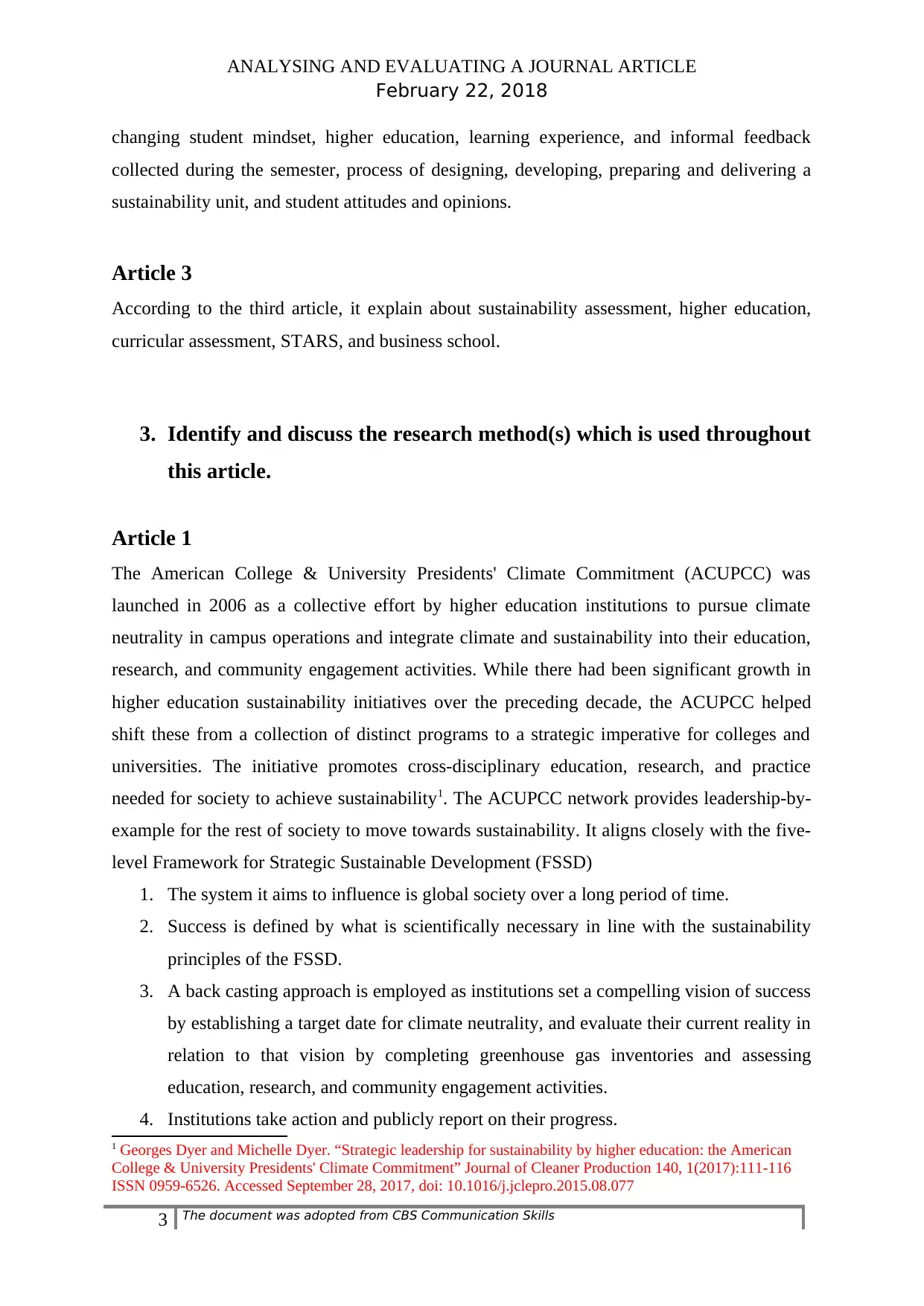
ANALYSING AND EVALUATING A JOURNAL ARTICLE
February 22, 2018
changing student mindset, higher education, learning experience, and informal feedback
collected during the semester, process of designing, developing, preparing and delivering a
sustainability unit, and student attitudes and opinions.
Article 3
According to the third article, it explain about sustainability assessment, higher education,
curricular assessment, STARS, and business school.
3. Identify and discuss the research method(s) which is used throughout
this article.
Article 1
The American College & University Presidents' Climate Commitment (ACUPCC) was
launched in 2006 as a collective effort by higher education institutions to pursue climate
neutrality in campus operations and integrate climate and sustainability into their education,
research, and community engagement activities. While there had been significant growth in
higher education sustainability initiatives over the preceding decade, the ACUPCC helped
shift these from a collection of distinct programs to a strategic imperative for colleges and
universities. The initiative promotes cross-disciplinary education, research, and practice
needed for society to achieve sustainability1. The ACUPCC network provides leadership-by-
example for the rest of society to move towards sustainability. It aligns closely with the five-
level Framework for Strategic Sustainable Development (FSSD)
1. The system it aims to influence is global society over a long period of time.
2. Success is defined by what is scientifically necessary in line with the sustainability
principles of the FSSD.
3. A back casting approach is employed as institutions set a compelling vision of success
by establishing a target date for climate neutrality, and evaluate their current reality in
relation to that vision by completing greenhouse gas inventories and assessing
education, research, and community engagement activities.
4. Institutions take action and publicly report on their progress.
1 Georges Dyer and Michelle Dyer. “Strategic leadership for sustainability by higher education: the American
College & University Presidents' Climate Commitment” Journal of Cleaner Production 140, 1(2017):111-116
ISSN 0959-6526. Accessed September 28, 2017, doi: 10.1016/j.jclepro.2015.08.077
3 The document was adopted from CBS Communication Skills
February 22, 2018
changing student mindset, higher education, learning experience, and informal feedback
collected during the semester, process of designing, developing, preparing and delivering a
sustainability unit, and student attitudes and opinions.
Article 3
According to the third article, it explain about sustainability assessment, higher education,
curricular assessment, STARS, and business school.
3. Identify and discuss the research method(s) which is used throughout
this article.
Article 1
The American College & University Presidents' Climate Commitment (ACUPCC) was
launched in 2006 as a collective effort by higher education institutions to pursue climate
neutrality in campus operations and integrate climate and sustainability into their education,
research, and community engagement activities. While there had been significant growth in
higher education sustainability initiatives over the preceding decade, the ACUPCC helped
shift these from a collection of distinct programs to a strategic imperative for colleges and
universities. The initiative promotes cross-disciplinary education, research, and practice
needed for society to achieve sustainability1. The ACUPCC network provides leadership-by-
example for the rest of society to move towards sustainability. It aligns closely with the five-
level Framework for Strategic Sustainable Development (FSSD)
1. The system it aims to influence is global society over a long period of time.
2. Success is defined by what is scientifically necessary in line with the sustainability
principles of the FSSD.
3. A back casting approach is employed as institutions set a compelling vision of success
by establishing a target date for climate neutrality, and evaluate their current reality in
relation to that vision by completing greenhouse gas inventories and assessing
education, research, and community engagement activities.
4. Institutions take action and publicly report on their progress.
1 Georges Dyer and Michelle Dyer. “Strategic leadership for sustainability by higher education: the American
College & University Presidents' Climate Commitment” Journal of Cleaner Production 140, 1(2017):111-116
ISSN 0959-6526. Accessed September 28, 2017, doi: 10.1016/j.jclepro.2015.08.077
3 The document was adopted from CBS Communication Skills
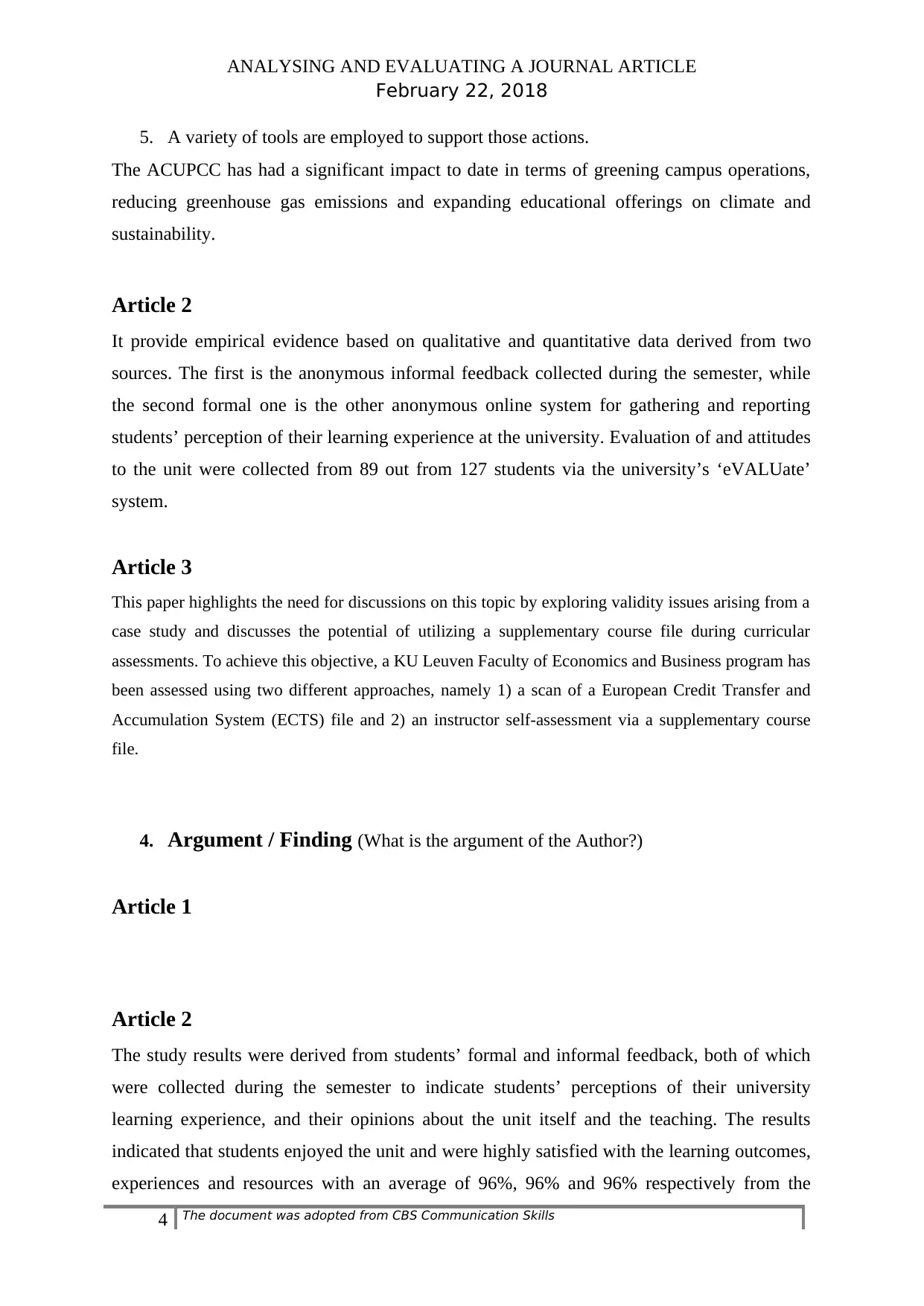
ANALYSING AND EVALUATING A JOURNAL ARTICLE
February 22, 2018
5. A variety of tools are employed to support those actions.
The ACUPCC has had a significant impact to date in terms of greening campus operations,
reducing greenhouse gas emissions and expanding educational offerings on climate and
sustainability.
Article 2
It provide empirical evidence based on qualitative and quantitative data derived from two
sources. The first is the anonymous informal feedback collected during the semester, while
the second formal one is the other anonymous online system for gathering and reporting
students’ perception of their learning experience at the university. Evaluation of and attitudes
to the unit were collected from 89 out from 127 students via the university’s ‘eVALUate’
system.
Article 3
This paper highlights the need for discussions on this topic by exploring validity issues arising from a
case study and discusses the potential of utilizing a supplementary course file during curricular
assessments. To achieve this objective, a KU Leuven Faculty of Economics and Business program has
been assessed using two different approaches, namely 1) a scan of a European Credit Transfer and
Accumulation System (ECTS) file and 2) an instructor self-assessment via a supplementary course
file.
4. Argument / Finding (What is the argument of the Author?)
Article 1
Article 2
The study results were derived from students’ formal and informal feedback, both of which
were collected during the semester to indicate students’ perceptions of their university
learning experience, and their opinions about the unit itself and the teaching. The results
indicated that students enjoyed the unit and were highly satisfied with the learning outcomes,
experiences and resources with an average of 96%, 96% and 96% respectively from the
4 The document was adopted from CBS Communication Skills
February 22, 2018
5. A variety of tools are employed to support those actions.
The ACUPCC has had a significant impact to date in terms of greening campus operations,
reducing greenhouse gas emissions and expanding educational offerings on climate and
sustainability.
Article 2
It provide empirical evidence based on qualitative and quantitative data derived from two
sources. The first is the anonymous informal feedback collected during the semester, while
the second formal one is the other anonymous online system for gathering and reporting
students’ perception of their learning experience at the university. Evaluation of and attitudes
to the unit were collected from 89 out from 127 students via the university’s ‘eVALUate’
system.
Article 3
This paper highlights the need for discussions on this topic by exploring validity issues arising from a
case study and discusses the potential of utilizing a supplementary course file during curricular
assessments. To achieve this objective, a KU Leuven Faculty of Economics and Business program has
been assessed using two different approaches, namely 1) a scan of a European Credit Transfer and
Accumulation System (ECTS) file and 2) an instructor self-assessment via a supplementary course
file.
4. Argument / Finding (What is the argument of the Author?)
Article 1
Article 2
The study results were derived from students’ formal and informal feedback, both of which
were collected during the semester to indicate students’ perceptions of their university
learning experience, and their opinions about the unit itself and the teaching. The results
indicated that students enjoyed the unit and were highly satisfied with the learning outcomes,
experiences and resources with an average of 96%, 96% and 96% respectively from the
4 The document was adopted from CBS Communication Skills
Secure Best Marks with AI Grader
Need help grading? Try our AI Grader for instant feedback on your assignments.
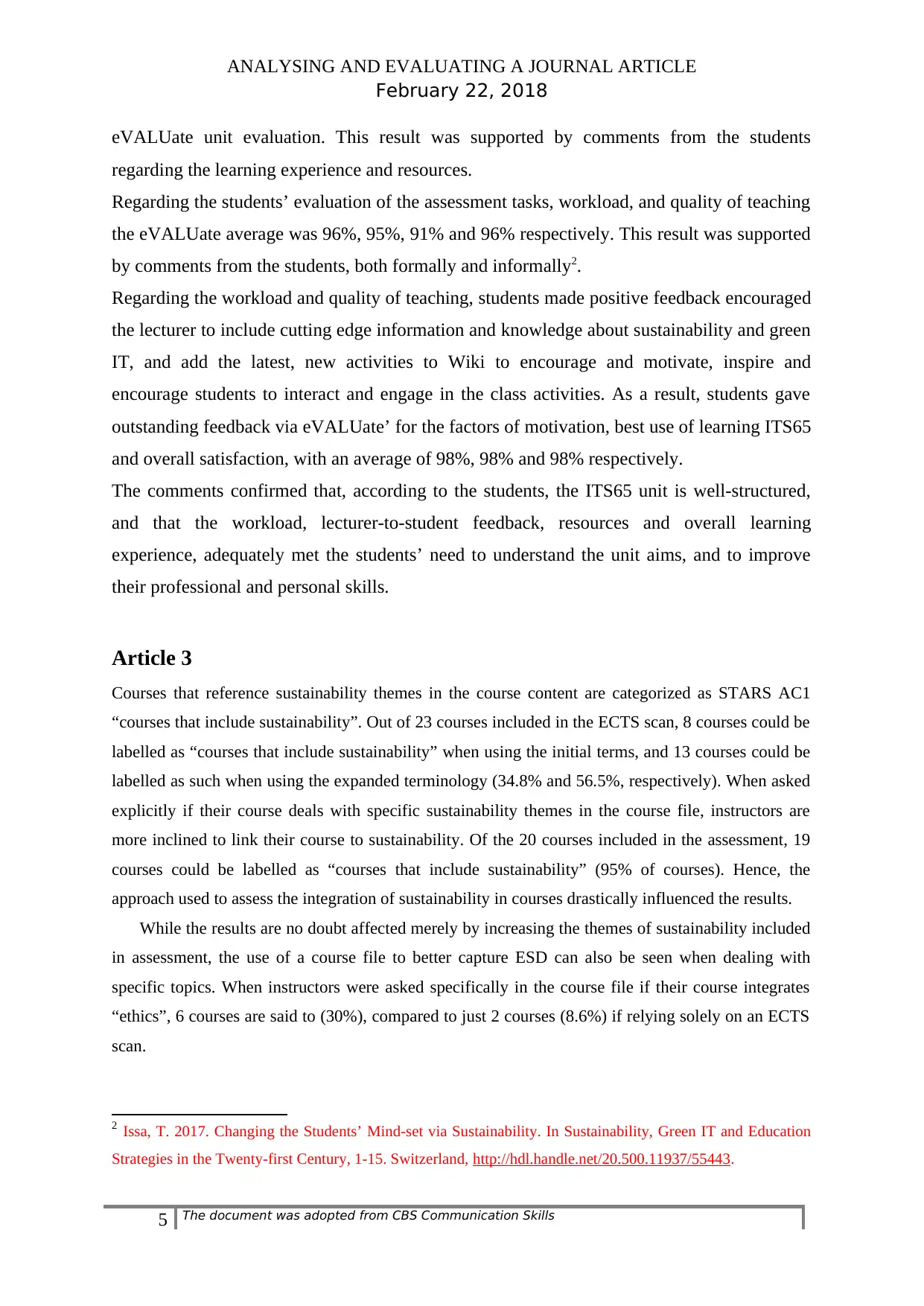
ANALYSING AND EVALUATING A JOURNAL ARTICLE
February 22, 2018
eVALUate unit evaluation. This result was supported by comments from the students
regarding the learning experience and resources.
Regarding the students’ evaluation of the assessment tasks, workload, and quality of teaching
the eVALUate average was 96%, 95%, 91% and 96% respectively. This result was supported
by comments from the students, both formally and informally2.
Regarding the workload and quality of teaching, students made positive feedback encouraged
the lecturer to include cutting edge information and knowledge about sustainability and green
IT, and add the latest, new activities to Wiki to encourage and motivate, inspire and
encourage students to interact and engage in the class activities. As a result, students gave
outstanding feedback via eVALUate’ for the factors of motivation, best use of learning ITS65
and overall satisfaction, with an average of 98%, 98% and 98% respectively.
The comments confirmed that, according to the students, the ITS65 unit is well-structured,
and that the workload, lecturer-to-student feedback, resources and overall learning
experience, adequately met the students’ need to understand the unit aims, and to improve
their professional and personal skills.
Article 3
Courses that reference sustainability themes in the course content are categorized as STARS AC1
“courses that include sustainability”. Out of 23 courses included in the ECTS scan, 8 courses could be
labelled as “courses that include sustainability” when using the initial terms, and 13 courses could be
labelled as such when using the expanded terminology (34.8% and 56.5%, respectively). When asked
explicitly if their course deals with specific sustainability themes in the course file, instructors are
more inclined to link their course to sustainability. Of the 20 courses included in the assessment, 19
courses could be labelled as “courses that include sustainability” (95% of courses). Hence, the
approach used to assess the integration of sustainability in courses drastically influenced the results.
While the results are no doubt affected merely by increasing the themes of sustainability included
in assessment, the use of a course file to better capture ESD can also be seen when dealing with
specific topics. When instructors were asked specifically in the course file if their course integrates
“ethics”, 6 courses are said to (30%), compared to just 2 courses (8.6%) if relying solely on an ECTS
scan.
2 Issa, T. 2017. Changing the Students’ Mind-set via Sustainability. In Sustainability, Green IT and Education
Strategies in the Twenty-first Century, 1-15. Switzerland, http://hdl.handle.net/20.500.11937/55443.
5 The document was adopted from CBS Communication Skills
February 22, 2018
eVALUate unit evaluation. This result was supported by comments from the students
regarding the learning experience and resources.
Regarding the students’ evaluation of the assessment tasks, workload, and quality of teaching
the eVALUate average was 96%, 95%, 91% and 96% respectively. This result was supported
by comments from the students, both formally and informally2.
Regarding the workload and quality of teaching, students made positive feedback encouraged
the lecturer to include cutting edge information and knowledge about sustainability and green
IT, and add the latest, new activities to Wiki to encourage and motivate, inspire and
encourage students to interact and engage in the class activities. As a result, students gave
outstanding feedback via eVALUate’ for the factors of motivation, best use of learning ITS65
and overall satisfaction, with an average of 98%, 98% and 98% respectively.
The comments confirmed that, according to the students, the ITS65 unit is well-structured,
and that the workload, lecturer-to-student feedback, resources and overall learning
experience, adequately met the students’ need to understand the unit aims, and to improve
their professional and personal skills.
Article 3
Courses that reference sustainability themes in the course content are categorized as STARS AC1
“courses that include sustainability”. Out of 23 courses included in the ECTS scan, 8 courses could be
labelled as “courses that include sustainability” when using the initial terms, and 13 courses could be
labelled as such when using the expanded terminology (34.8% and 56.5%, respectively). When asked
explicitly if their course deals with specific sustainability themes in the course file, instructors are
more inclined to link their course to sustainability. Of the 20 courses included in the assessment, 19
courses could be labelled as “courses that include sustainability” (95% of courses). Hence, the
approach used to assess the integration of sustainability in courses drastically influenced the results.
While the results are no doubt affected merely by increasing the themes of sustainability included
in assessment, the use of a course file to better capture ESD can also be seen when dealing with
specific topics. When instructors were asked specifically in the course file if their course integrates
“ethics”, 6 courses are said to (30%), compared to just 2 courses (8.6%) if relying solely on an ECTS
scan.
2 Issa, T. 2017. Changing the Students’ Mind-set via Sustainability. In Sustainability, Green IT and Education
Strategies in the Twenty-first Century, 1-15. Switzerland, http://hdl.handle.net/20.500.11937/55443.
5 The document was adopted from CBS Communication Skills
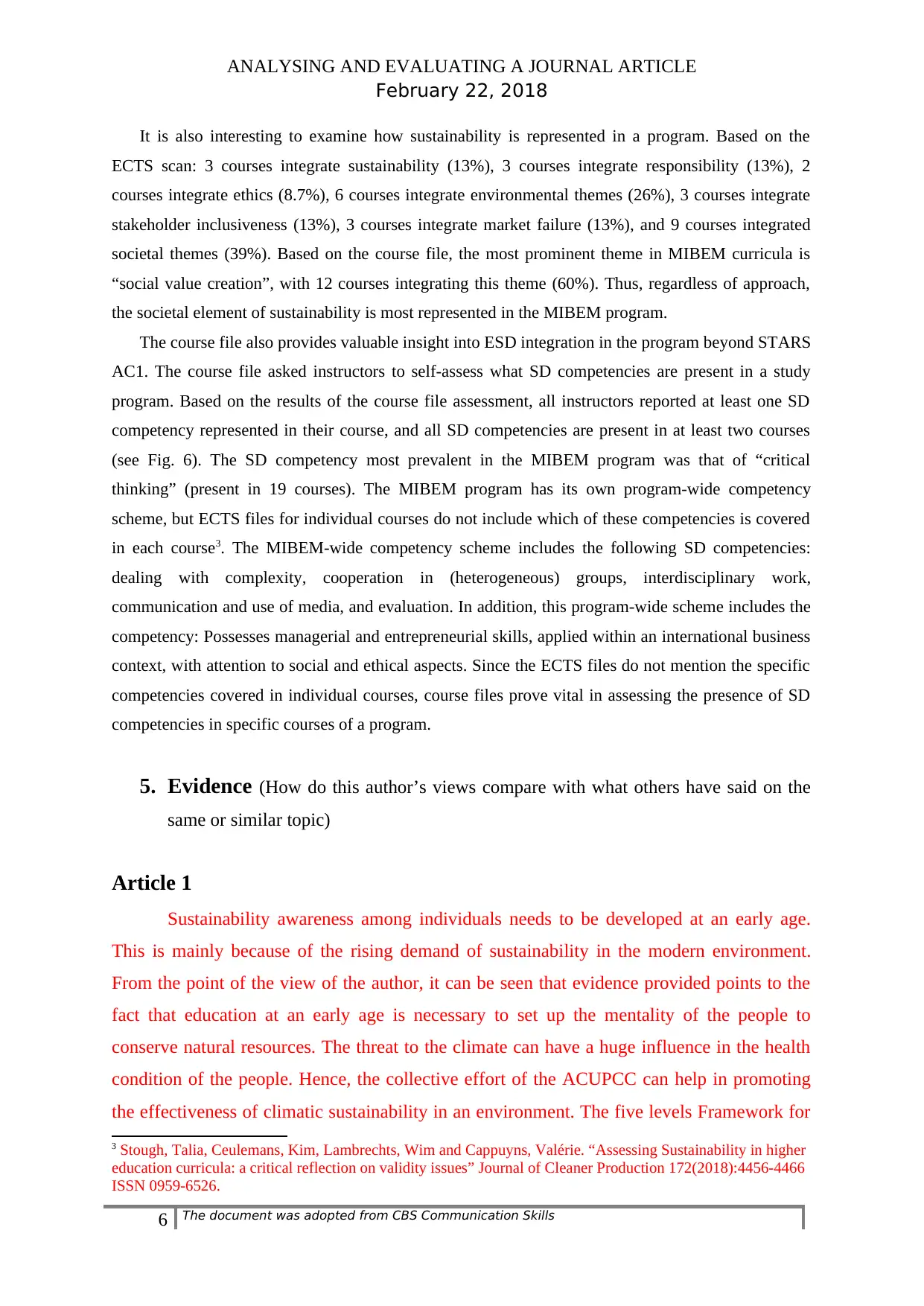
ANALYSING AND EVALUATING A JOURNAL ARTICLE
February 22, 2018
It is also interesting to examine how sustainability is represented in a program. Based on the
ECTS scan: 3 courses integrate sustainability (13%), 3 courses integrate responsibility (13%), 2
courses integrate ethics (8.7%), 6 courses integrate environmental themes (26%), 3 courses integrate
stakeholder inclusiveness (13%), 3 courses integrate market failure (13%), and 9 courses integrated
societal themes (39%). Based on the course file, the most prominent theme in MIBEM curricula is
“social value creation”, with 12 courses integrating this theme (60%). Thus, regardless of approach,
the societal element of sustainability is most represented in the MIBEM program.
The course file also provides valuable insight into ESD integration in the program beyond STARS
AC1. The course file asked instructors to self-assess what SD competencies are present in a study
program. Based on the results of the course file assessment, all instructors reported at least one SD
competency represented in their course, and all SD competencies are present in at least two courses
(see Fig. 6). The SD competency most prevalent in the MIBEM program was that of “critical
thinking” (present in 19 courses). The MIBEM program has its own program-wide competency
scheme, but ECTS files for individual courses do not include which of these competencies is covered
in each course3. The MIBEM-wide competency scheme includes the following SD competencies:
dealing with complexity, cooperation in (heterogeneous) groups, interdisciplinary work,
communication and use of media, and evaluation. In addition, this program-wide scheme includes the
competency: Possesses managerial and entrepreneurial skills, applied within an international business
context, with attention to social and ethical aspects. Since the ECTS files do not mention the specific
competencies covered in individual courses, course files prove vital in assessing the presence of SD
competencies in specific courses of a program.
5. Evidence (How do this author’s views compare with what others have said on the
same or similar topic)
Article 1
Sustainability awareness among individuals needs to be developed at an early age.
This is mainly because of the rising demand of sustainability in the modern environment.
From the point of the view of the author, it can be seen that evidence provided points to the
fact that education at an early age is necessary to set up the mentality of the people to
conserve natural resources. The threat to the climate can have a huge influence in the health
condition of the people. Hence, the collective effort of the ACUPCC can help in promoting
the effectiveness of climatic sustainability in an environment. The five levels Framework for
3 Stough, Talia, Ceulemans, Kim, Lambrechts, Wim and Cappuyns, Valérie. “Assessing Sustainability in higher
education curricula: a critical reflection on validity issues” Journal of Cleaner Production 172(2018):4456-4466
ISSN 0959-6526.
6 The document was adopted from CBS Communication Skills
February 22, 2018
It is also interesting to examine how sustainability is represented in a program. Based on the
ECTS scan: 3 courses integrate sustainability (13%), 3 courses integrate responsibility (13%), 2
courses integrate ethics (8.7%), 6 courses integrate environmental themes (26%), 3 courses integrate
stakeholder inclusiveness (13%), 3 courses integrate market failure (13%), and 9 courses integrated
societal themes (39%). Based on the course file, the most prominent theme in MIBEM curricula is
“social value creation”, with 12 courses integrating this theme (60%). Thus, regardless of approach,
the societal element of sustainability is most represented in the MIBEM program.
The course file also provides valuable insight into ESD integration in the program beyond STARS
AC1. The course file asked instructors to self-assess what SD competencies are present in a study
program. Based on the results of the course file assessment, all instructors reported at least one SD
competency represented in their course, and all SD competencies are present in at least two courses
(see Fig. 6). The SD competency most prevalent in the MIBEM program was that of “critical
thinking” (present in 19 courses). The MIBEM program has its own program-wide competency
scheme, but ECTS files for individual courses do not include which of these competencies is covered
in each course3. The MIBEM-wide competency scheme includes the following SD competencies:
dealing with complexity, cooperation in (heterogeneous) groups, interdisciplinary work,
communication and use of media, and evaluation. In addition, this program-wide scheme includes the
competency: Possesses managerial and entrepreneurial skills, applied within an international business
context, with attention to social and ethical aspects. Since the ECTS files do not mention the specific
competencies covered in individual courses, course files prove vital in assessing the presence of SD
competencies in specific courses of a program.
5. Evidence (How do this author’s views compare with what others have said on the
same or similar topic)
Article 1
Sustainability awareness among individuals needs to be developed at an early age.
This is mainly because of the rising demand of sustainability in the modern environment.
From the point of the view of the author, it can be seen that evidence provided points to the
fact that education at an early age is necessary to set up the mentality of the people to
conserve natural resources. The threat to the climate can have a huge influence in the health
condition of the people. Hence, the collective effort of the ACUPCC can help in promoting
the effectiveness of climatic sustainability in an environment. The five levels Framework for
3 Stough, Talia, Ceulemans, Kim, Lambrechts, Wim and Cappuyns, Valérie. “Assessing Sustainability in higher
education curricula: a critical reflection on validity issues” Journal of Cleaner Production 172(2018):4456-4466
ISSN 0959-6526.
6 The document was adopted from CBS Communication Skills
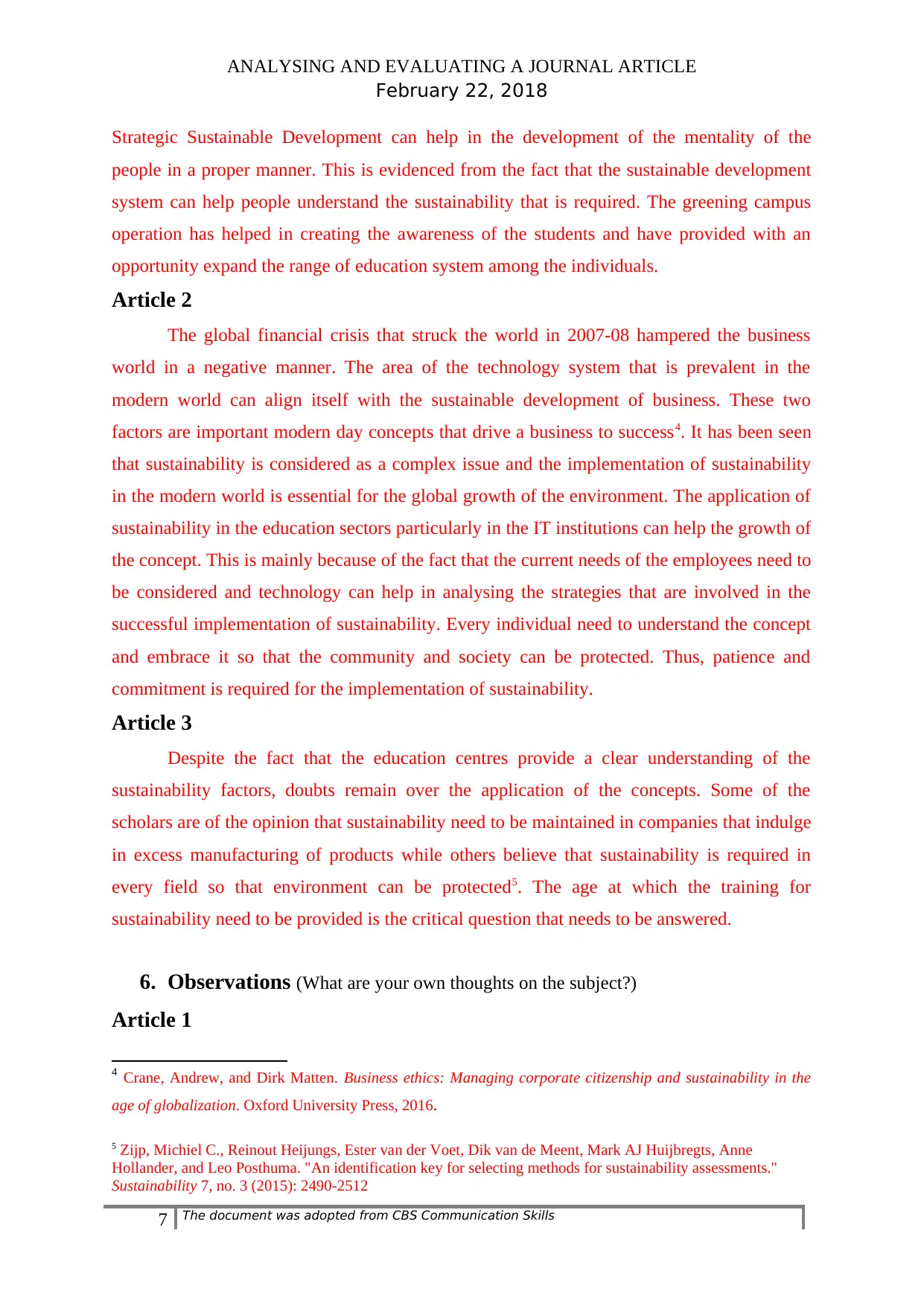
ANALYSING AND EVALUATING A JOURNAL ARTICLE
February 22, 2018
Strategic Sustainable Development can help in the development of the mentality of the
people in a proper manner. This is evidenced from the fact that the sustainable development
system can help people understand the sustainability that is required. The greening campus
operation has helped in creating the awareness of the students and have provided with an
opportunity expand the range of education system among the individuals.
Article 2
The global financial crisis that struck the world in 2007-08 hampered the business
world in a negative manner. The area of the technology system that is prevalent in the
modern world can align itself with the sustainable development of business. These two
factors are important modern day concepts that drive a business to success4. It has been seen
that sustainability is considered as a complex issue and the implementation of sustainability
in the modern world is essential for the global growth of the environment. The application of
sustainability in the education sectors particularly in the IT institutions can help the growth of
the concept. This is mainly because of the fact that the current needs of the employees need to
be considered and technology can help in analysing the strategies that are involved in the
successful implementation of sustainability. Every individual need to understand the concept
and embrace it so that the community and society can be protected. Thus, patience and
commitment is required for the implementation of sustainability.
Article 3
Despite the fact that the education centres provide a clear understanding of the
sustainability factors, doubts remain over the application of the concepts. Some of the
scholars are of the opinion that sustainability need to be maintained in companies that indulge
in excess manufacturing of products while others believe that sustainability is required in
every field so that environment can be protected5. The age at which the training for
sustainability need to be provided is the critical question that needs to be answered.
6. Observations (What are your own thoughts on the subject?)
Article 1
4 Crane, Andrew, and Dirk Matten. Business ethics: Managing corporate citizenship and sustainability in the
age of globalization. Oxford University Press, 2016.
5 Zijp, Michiel C., Reinout Heijungs, Ester van der Voet, Dik van de Meent, Mark AJ Huijbregts, Anne
Hollander, and Leo Posthuma. "An identification key for selecting methods for sustainability assessments."
Sustainability 7, no. 3 (2015): 2490-2512
7 The document was adopted from CBS Communication Skills
February 22, 2018
Strategic Sustainable Development can help in the development of the mentality of the
people in a proper manner. This is evidenced from the fact that the sustainable development
system can help people understand the sustainability that is required. The greening campus
operation has helped in creating the awareness of the students and have provided with an
opportunity expand the range of education system among the individuals.
Article 2
The global financial crisis that struck the world in 2007-08 hampered the business
world in a negative manner. The area of the technology system that is prevalent in the
modern world can align itself with the sustainable development of business. These two
factors are important modern day concepts that drive a business to success4. It has been seen
that sustainability is considered as a complex issue and the implementation of sustainability
in the modern world is essential for the global growth of the environment. The application of
sustainability in the education sectors particularly in the IT institutions can help the growth of
the concept. This is mainly because of the fact that the current needs of the employees need to
be considered and technology can help in analysing the strategies that are involved in the
successful implementation of sustainability. Every individual need to understand the concept
and embrace it so that the community and society can be protected. Thus, patience and
commitment is required for the implementation of sustainability.
Article 3
Despite the fact that the education centres provide a clear understanding of the
sustainability factors, doubts remain over the application of the concepts. Some of the
scholars are of the opinion that sustainability need to be maintained in companies that indulge
in excess manufacturing of products while others believe that sustainability is required in
every field so that environment can be protected5. The age at which the training for
sustainability need to be provided is the critical question that needs to be answered.
6. Observations (What are your own thoughts on the subject?)
Article 1
4 Crane, Andrew, and Dirk Matten. Business ethics: Managing corporate citizenship and sustainability in the
age of globalization. Oxford University Press, 2016.
5 Zijp, Michiel C., Reinout Heijungs, Ester van der Voet, Dik van de Meent, Mark AJ Huijbregts, Anne
Hollander, and Leo Posthuma. "An identification key for selecting methods for sustainability assessments."
Sustainability 7, no. 3 (2015): 2490-2512
7 The document was adopted from CBS Communication Skills
Paraphrase This Document
Need a fresh take? Get an instant paraphrase of this document with our AI Paraphraser
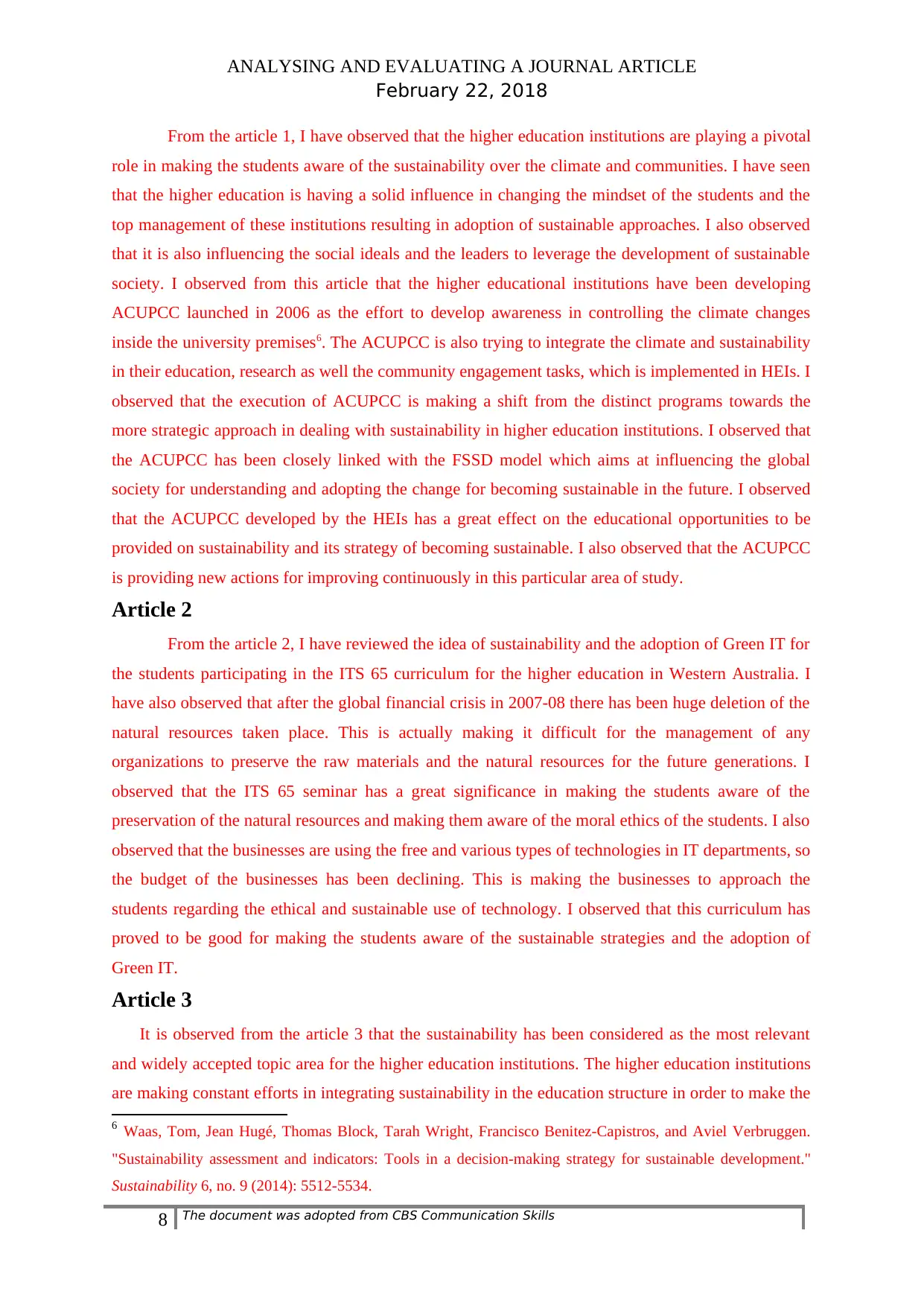
ANALYSING AND EVALUATING A JOURNAL ARTICLE
February 22, 2018
From the article 1, I have observed that the higher education institutions are playing a pivotal
role in making the students aware of the sustainability over the climate and communities. I have seen
that the higher education is having a solid influence in changing the mindset of the students and the
top management of these institutions resulting in adoption of sustainable approaches. I also observed
that it is also influencing the social ideals and the leaders to leverage the development of sustainable
society. I observed from this article that the higher educational institutions have been developing
ACUPCC launched in 2006 as the effort to develop awareness in controlling the climate changes
inside the university premises6. The ACUPCC is also trying to integrate the climate and sustainability
in their education, research as well the community engagement tasks, which is implemented in HEIs. I
observed that the execution of ACUPCC is making a shift from the distinct programs towards the
more strategic approach in dealing with sustainability in higher education institutions. I observed that
the ACUPCC has been closely linked with the FSSD model which aims at influencing the global
society for understanding and adopting the change for becoming sustainable in the future. I observed
that the ACUPCC developed by the HEIs has a great effect on the educational opportunities to be
provided on sustainability and its strategy of becoming sustainable. I also observed that the ACUPCC
is providing new actions for improving continuously in this particular area of study.
Article 2
From the article 2, I have reviewed the idea of sustainability and the adoption of Green IT for
the students participating in the ITS 65 curriculum for the higher education in Western Australia. I
have also observed that after the global financial crisis in 2007-08 there has been huge deletion of the
natural resources taken place. This is actually making it difficult for the management of any
organizations to preserve the raw materials and the natural resources for the future generations. I
observed that the ITS 65 seminar has a great significance in making the students aware of the
preservation of the natural resources and making them aware of the moral ethics of the students. I also
observed that the businesses are using the free and various types of technologies in IT departments, so
the budget of the businesses has been declining. This is making the businesses to approach the
students regarding the ethical and sustainable use of technology. I observed that this curriculum has
proved to be good for making the students aware of the sustainable strategies and the adoption of
Green IT.
Article 3
It is observed from the article 3 that the sustainability has been considered as the most relevant
and widely accepted topic area for the higher education institutions. The higher education institutions
are making constant efforts in integrating sustainability in the education structure in order to make the
6 Waas, Tom, Jean Hugé, Thomas Block, Tarah Wright, Francisco Benitez-Capistros, and Aviel Verbruggen.
"Sustainability assessment and indicators: Tools in a decision-making strategy for sustainable development."
Sustainability 6, no. 9 (2014): 5512-5534.
8 The document was adopted from CBS Communication Skills
February 22, 2018
From the article 1, I have observed that the higher education institutions are playing a pivotal
role in making the students aware of the sustainability over the climate and communities. I have seen
that the higher education is having a solid influence in changing the mindset of the students and the
top management of these institutions resulting in adoption of sustainable approaches. I also observed
that it is also influencing the social ideals and the leaders to leverage the development of sustainable
society. I observed from this article that the higher educational institutions have been developing
ACUPCC launched in 2006 as the effort to develop awareness in controlling the climate changes
inside the university premises6. The ACUPCC is also trying to integrate the climate and sustainability
in their education, research as well the community engagement tasks, which is implemented in HEIs. I
observed that the execution of ACUPCC is making a shift from the distinct programs towards the
more strategic approach in dealing with sustainability in higher education institutions. I observed that
the ACUPCC has been closely linked with the FSSD model which aims at influencing the global
society for understanding and adopting the change for becoming sustainable in the future. I observed
that the ACUPCC developed by the HEIs has a great effect on the educational opportunities to be
provided on sustainability and its strategy of becoming sustainable. I also observed that the ACUPCC
is providing new actions for improving continuously in this particular area of study.
Article 2
From the article 2, I have reviewed the idea of sustainability and the adoption of Green IT for
the students participating in the ITS 65 curriculum for the higher education in Western Australia. I
have also observed that after the global financial crisis in 2007-08 there has been huge deletion of the
natural resources taken place. This is actually making it difficult for the management of any
organizations to preserve the raw materials and the natural resources for the future generations. I
observed that the ITS 65 seminar has a great significance in making the students aware of the
preservation of the natural resources and making them aware of the moral ethics of the students. I also
observed that the businesses are using the free and various types of technologies in IT departments, so
the budget of the businesses has been declining. This is making the businesses to approach the
students regarding the ethical and sustainable use of technology. I observed that this curriculum has
proved to be good for making the students aware of the sustainable strategies and the adoption of
Green IT.
Article 3
It is observed from the article 3 that the sustainability has been considered as the most relevant
and widely accepted topic area for the higher education institutions. The higher education institutions
are making constant efforts in integrating sustainability in the education structure in order to make the
6 Waas, Tom, Jean Hugé, Thomas Block, Tarah Wright, Francisco Benitez-Capistros, and Aviel Verbruggen.
"Sustainability assessment and indicators: Tools in a decision-making strategy for sustainable development."
Sustainability 6, no. 9 (2014): 5512-5534.
8 The document was adopted from CBS Communication Skills
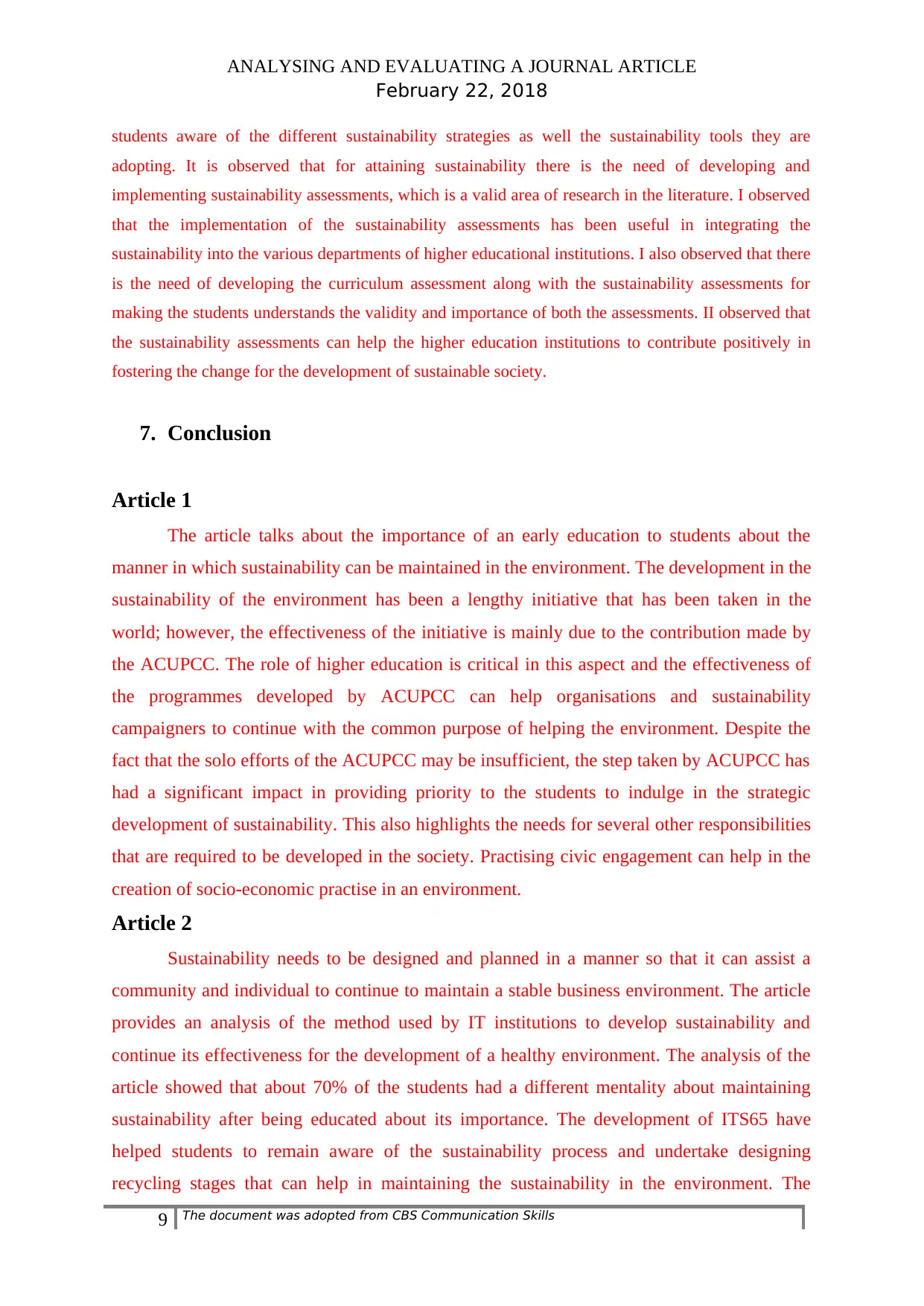
ANALYSING AND EVALUATING A JOURNAL ARTICLE
February 22, 2018
students aware of the different sustainability strategies as well the sustainability tools they are
adopting. It is observed that for attaining sustainability there is the need of developing and
implementing sustainability assessments, which is a valid area of research in the literature. I observed
that the implementation of the sustainability assessments has been useful in integrating the
sustainability into the various departments of higher educational institutions. I also observed that there
is the need of developing the curriculum assessment along with the sustainability assessments for
making the students understands the validity and importance of both the assessments. II observed that
the sustainability assessments can help the higher education institutions to contribute positively in
fostering the change for the development of sustainable society.
7. Conclusion
Article 1
The article talks about the importance of an early education to students about the
manner in which sustainability can be maintained in the environment. The development in the
sustainability of the environment has been a lengthy initiative that has been taken in the
world; however, the effectiveness of the initiative is mainly due to the contribution made by
the ACUPCC. The role of higher education is critical in this aspect and the effectiveness of
the programmes developed by ACUPCC can help organisations and sustainability
campaigners to continue with the common purpose of helping the environment. Despite the
fact that the solo efforts of the ACUPCC may be insufficient, the step taken by ACUPCC has
had a significant impact in providing priority to the students to indulge in the strategic
development of sustainability. This also highlights the needs for several other responsibilities
that are required to be developed in the society. Practising civic engagement can help in the
creation of socio-economic practise in an environment.
Article 2
Sustainability needs to be designed and planned in a manner so that it can assist a
community and individual to continue to maintain a stable business environment. The article
provides an analysis of the method used by IT institutions to develop sustainability and
continue its effectiveness for the development of a healthy environment. The analysis of the
article showed that about 70% of the students had a different mentality about maintaining
sustainability after being educated about its importance. The development of ITS65 have
helped students to remain aware of the sustainability process and undertake designing
recycling stages that can help in maintaining the sustainability in the environment. The
9 The document was adopted from CBS Communication Skills
February 22, 2018
students aware of the different sustainability strategies as well the sustainability tools they are
adopting. It is observed that for attaining sustainability there is the need of developing and
implementing sustainability assessments, which is a valid area of research in the literature. I observed
that the implementation of the sustainability assessments has been useful in integrating the
sustainability into the various departments of higher educational institutions. I also observed that there
is the need of developing the curriculum assessment along with the sustainability assessments for
making the students understands the validity and importance of both the assessments. II observed that
the sustainability assessments can help the higher education institutions to contribute positively in
fostering the change for the development of sustainable society.
7. Conclusion
Article 1
The article talks about the importance of an early education to students about the
manner in which sustainability can be maintained in the environment. The development in the
sustainability of the environment has been a lengthy initiative that has been taken in the
world; however, the effectiveness of the initiative is mainly due to the contribution made by
the ACUPCC. The role of higher education is critical in this aspect and the effectiveness of
the programmes developed by ACUPCC can help organisations and sustainability
campaigners to continue with the common purpose of helping the environment. Despite the
fact that the solo efforts of the ACUPCC may be insufficient, the step taken by ACUPCC has
had a significant impact in providing priority to the students to indulge in the strategic
development of sustainability. This also highlights the needs for several other responsibilities
that are required to be developed in the society. Practising civic engagement can help in the
creation of socio-economic practise in an environment.
Article 2
Sustainability needs to be designed and planned in a manner so that it can assist a
community and individual to continue to maintain a stable business environment. The article
provides an analysis of the method used by IT institutions to develop sustainability and
continue its effectiveness for the development of a healthy environment. The analysis of the
article showed that about 70% of the students had a different mentality about maintaining
sustainability after being educated about its importance. The development of ITS65 have
helped students to remain aware of the sustainability process and undertake designing
recycling stages that can help in maintaining the sustainability in the environment. The
9 The document was adopted from CBS Communication Skills
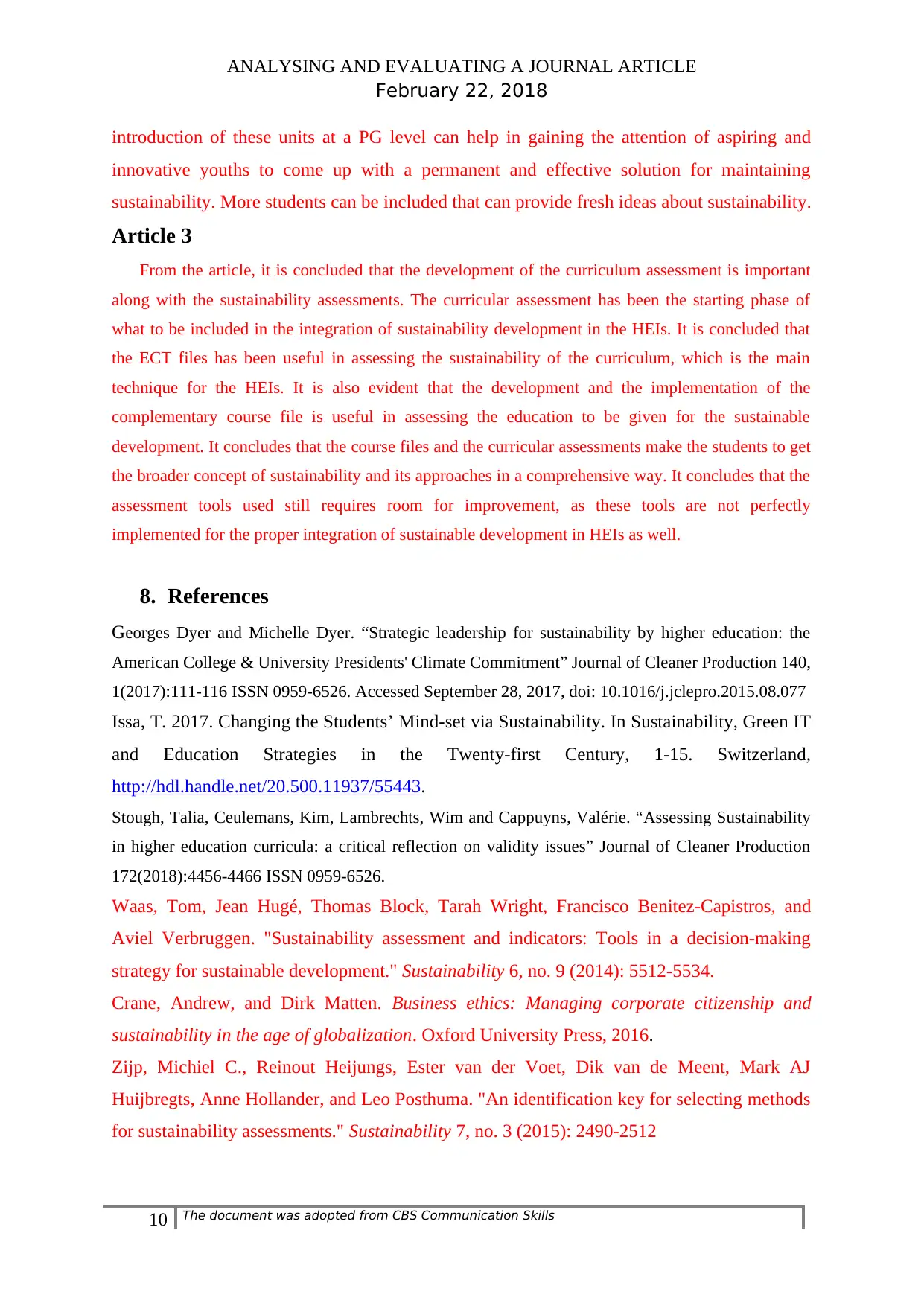
ANALYSING AND EVALUATING A JOURNAL ARTICLE
February 22, 2018
introduction of these units at a PG level can help in gaining the attention of aspiring and
innovative youths to come up with a permanent and effective solution for maintaining
sustainability. More students can be included that can provide fresh ideas about sustainability.
Article 3
From the article, it is concluded that the development of the curriculum assessment is important
along with the sustainability assessments. The curricular assessment has been the starting phase of
what to be included in the integration of sustainability development in the HEIs. It is concluded that
the ECT files has been useful in assessing the sustainability of the curriculum, which is the main
technique for the HEIs. It is also evident that the development and the implementation of the
complementary course file is useful in assessing the education to be given for the sustainable
development. It concludes that the course files and the curricular assessments make the students to get
the broader concept of sustainability and its approaches in a comprehensive way. It concludes that the
assessment tools used still requires room for improvement, as these tools are not perfectly
implemented for the proper integration of sustainable development in HEIs as well.
8. References
Georges Dyer and Michelle Dyer. “Strategic leadership for sustainability by higher education: the
American College & University Presidents' Climate Commitment” Journal of Cleaner Production 140,
1(2017):111-116 ISSN 0959-6526. Accessed September 28, 2017, doi: 10.1016/j.jclepro.2015.08.077
Issa, T. 2017. Changing the Students’ Mind-set via Sustainability. In Sustainability, Green IT
and Education Strategies in the Twenty-first Century, 1-15. Switzerland,
http://hdl.handle.net/20.500.11937/55443.
Stough, Talia, Ceulemans, Kim, Lambrechts, Wim and Cappuyns, Valérie. “Assessing Sustainability
in higher education curricula: a critical reflection on validity issues” Journal of Cleaner Production
172(2018):4456-4466 ISSN 0959-6526.
Waas, Tom, Jean Hugé, Thomas Block, Tarah Wright, Francisco Benitez-Capistros, and
Aviel Verbruggen. "Sustainability assessment and indicators: Tools in a decision-making
strategy for sustainable development." Sustainability 6, no. 9 (2014): 5512-5534.
Crane, Andrew, and Dirk Matten. Business ethics: Managing corporate citizenship and
sustainability in the age of globalization. Oxford University Press, 2016.
Zijp, Michiel C., Reinout Heijungs, Ester van der Voet, Dik van de Meent, Mark AJ
Huijbregts, Anne Hollander, and Leo Posthuma. "An identification key for selecting methods
for sustainability assessments." Sustainability 7, no. 3 (2015): 2490-2512
10 The document was adopted from CBS Communication Skills
February 22, 2018
introduction of these units at a PG level can help in gaining the attention of aspiring and
innovative youths to come up with a permanent and effective solution for maintaining
sustainability. More students can be included that can provide fresh ideas about sustainability.
Article 3
From the article, it is concluded that the development of the curriculum assessment is important
along with the sustainability assessments. The curricular assessment has been the starting phase of
what to be included in the integration of sustainability development in the HEIs. It is concluded that
the ECT files has been useful in assessing the sustainability of the curriculum, which is the main
technique for the HEIs. It is also evident that the development and the implementation of the
complementary course file is useful in assessing the education to be given for the sustainable
development. It concludes that the course files and the curricular assessments make the students to get
the broader concept of sustainability and its approaches in a comprehensive way. It concludes that the
assessment tools used still requires room for improvement, as these tools are not perfectly
implemented for the proper integration of sustainable development in HEIs as well.
8. References
Georges Dyer and Michelle Dyer. “Strategic leadership for sustainability by higher education: the
American College & University Presidents' Climate Commitment” Journal of Cleaner Production 140,
1(2017):111-116 ISSN 0959-6526. Accessed September 28, 2017, doi: 10.1016/j.jclepro.2015.08.077
Issa, T. 2017. Changing the Students’ Mind-set via Sustainability. In Sustainability, Green IT
and Education Strategies in the Twenty-first Century, 1-15. Switzerland,
http://hdl.handle.net/20.500.11937/55443.
Stough, Talia, Ceulemans, Kim, Lambrechts, Wim and Cappuyns, Valérie. “Assessing Sustainability
in higher education curricula: a critical reflection on validity issues” Journal of Cleaner Production
172(2018):4456-4466 ISSN 0959-6526.
Waas, Tom, Jean Hugé, Thomas Block, Tarah Wright, Francisco Benitez-Capistros, and
Aviel Verbruggen. "Sustainability assessment and indicators: Tools in a decision-making
strategy for sustainable development." Sustainability 6, no. 9 (2014): 5512-5534.
Crane, Andrew, and Dirk Matten. Business ethics: Managing corporate citizenship and
sustainability in the age of globalization. Oxford University Press, 2016.
Zijp, Michiel C., Reinout Heijungs, Ester van der Voet, Dik van de Meent, Mark AJ
Huijbregts, Anne Hollander, and Leo Posthuma. "An identification key for selecting methods
for sustainability assessments." Sustainability 7, no. 3 (2015): 2490-2512
10 The document was adopted from CBS Communication Skills
1 out of 10
Your All-in-One AI-Powered Toolkit for Academic Success.
+13062052269
info@desklib.com
Available 24*7 on WhatsApp / Email
![[object Object]](/_next/static/media/star-bottom.7253800d.svg)
Unlock your academic potential
© 2024 | Zucol Services PVT LTD | All rights reserved.